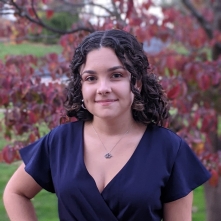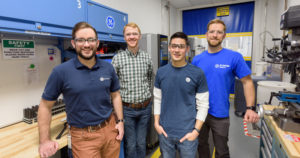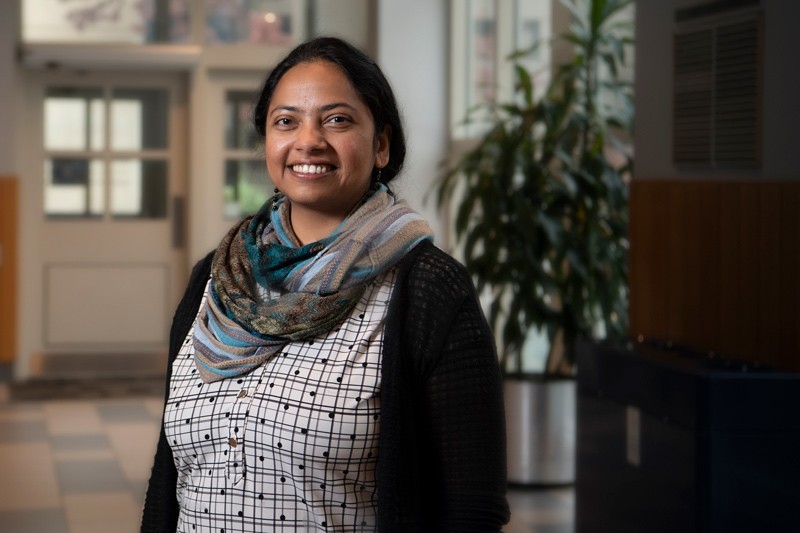Prof. Haritha Malladi says a willingness to learn ‘is the only mindset you need’
Editor’s note: First-year students, prospective students (and some of their parents) wonder and worry how they will handle the academic transition from high school to college. In a series of stories, UDaily speaks with University of Delaware professors who teach courses commonly taken by students during their first year on campus. The series includes professors who teach biology, writing, business, calculus, political science and sociology, and those stories can be read on the How I Teach website. In this story Assistant Professor Haritha Malladi, who is director of First-Year Engineering, explains her approach to teaching Introduction to Engineering.
Haritha Malladi has a secret that could blow an entire industry wide open.
Professional engineers? They are not the human calculators you think they are. They cannot necessarily rattle off complex equations for determining, say, force, energy or — deep breath — the solubility of carbon dioxide in tetraalkyl phosphonium-based ionic liquids. Some engineers are not even all that fond of advanced physics or calculus — they simply like solving the world’s problems.
In other words, when it comes to complicated formulas and theorems, “we look things up as we need them,” said Malladi, director of the first-year engineering program at the University of Delaware.
This kind of approachable real-talk is partly what makes the assistant professor a favorite among first-year Blue Hens enrolled in EGGG101, better known as Intro to Engineering. In this class, students learn from Malladi the secret to success in their chosen field. It is not, as many who enter UD believe, the skills typically associated with the science, technology, engineering and math (STEM) curriculum, important as those might be. Rather, real success lies more with so-called durable skills: leadership, communication and — above all — collaboration.
“I truly believe that everyone can develop these,” Malladi said. “I emphasize that, regardless of background, everyone belongs in engineering. The only mindset you need is a willingness to learn.”
If this all sounds a bit kumbaya for a course of study traditionally considered cutthroat, well… that’s because it is. Malladi encourages her students to work with — rather than compete against — one another. And this culture of support pays great dividends.

First-year Engineering student Geogia Angeletakis holds the birchwood model of the University’s YouDee mascot, complete with flapping wings. Beyond the mascot rah-rah, the task and requirements helped Angeletakis realize the value of people working effectively as a team to solve a problem.
“I was so nervous before starting — nervous I would feel overwhelmed, nervous there would be more physics than I could handle and nervous I would fall behind my classmates,” said Georgia Angeletakis, an Honors student who took EGGG101 in the fall of 2021. “But I really want people to know: Intro to engineering is not that scary — it is so team-oriented, and everything is broken down into manageable chunks. Now, because I have this foundation, I feel ready and excited for the rest of my engineering courses.”
Over the course of a semester in EGGG101, more than 650 students across two class sections work in groups of five, each team drawing from a variety of engineering majors for an interdisciplinary approach. For one months-long project, the Blue Hens must design from an 8-by-10 sheet of birchwood a 3-D, mechanical puzzle — aka, a puzzle with moving parts that does not rely on glue or tape to come together. The assignment is called UDGears, a play on the name of a Ukrainian toy company, UGears, that sells similar models.
Even for a self-described competitive student whose mode of high school operation was to tackle the bulk of group-project work herself lest a peer underperform, Angeletakis found the team aspect of EGGG101 rewarding — Malladi, she explained, inspired everyone to pull their weight.
“At the beginning, I had very little confidence that my team could actually do this,” said Angeletakis, whose group designed a birchwood model of the University’s YouDee mascot, complete with flapping wings. “But we learned to trust one another, and I can’t believe what we were able to accomplish. I’ve discovered that engineering is a group activity, and there is nothing wrong with that — it’s those bonds that allow you to do beautiful things.”
This group harmony is due partly to a so-called norms document that Malladi has her students create at the beginning of each semester. Such contracts force the teams to outline their core values, their operating principles and their expectations for one another and themselves, establishing a set of guidelines they can return to should any conflict arise.
Throughout the semester, Malladi also urges her students to remember: Sure, you are here to learn and work, but it’s okay to “have fun and be creative along the way,” she said, adding that enhancing joy is a job requirement for those entering the field — at least according to the National Academy of Engineering.

Alexandra Zurzolo, a junior mechanical engineering major, served as a peer mentor in Malladi’s class during the fall of 2021.
But — make no mistake — no matter how well a team works together or how much fun they manage to have, the concepts needed to finish the EGGG101 tasks are difficult — spatial visualization, budding engineers will tell you, is not for the faint of heart. When a topic becomes a little too tricky, students can rely on their peer leaders, veterans of the course assigned to mentor individual groups. These upperclassmen provide guidance on everything from confounding math problems to broader questions about college life, like how to register for classes or, even, where on campus to go for the best post-exam lunch splurge.
“It is all about creating a sense of community early on,” said Alexandra Zurzolo, a junior Honors mechanical engineering major who served as a peer mentor in Malladi’s class during the fall of 2021. “There are many things I wish I’d known as a first-year student, so I welcome the opportunity to offer that advice. I make a point to learn everyone’s name, and I encourage the students to feel comfortable asking questions, because that is how you learn. The peer mentors are always looking to help.”
Even with this climate of support, projects sometimes go awry. Engineering, after all, is a field built on trial and error — emphasis on error. So if a group’s final puzzle product falls apart into more of a, well, puzzling mess? Learning objectives (and a decent grade) can still be obtained.
“One hundred percent of the time, I do not expect a prototype to be perfect,” Malladi said. “That would be an almost impossible thing. The goal of the class is, rather, to learn from your mistakes, document what you’ve done and define what the path forward is for a future iteration. What would the students change the next time around, if they had the opportunity? Is moving forward with this design even viable? Sometimes, as an engineer, it is making the decision to stop that is the important thing.”
This permission to not be perfect — to not censor themselves as they dream up big ideas — is one of the takeaways Malladi hopes her students carry with them throughout their academic careers and beyond.
For Angeletakis, this mentality has proven helpful every time she starts feeling overwhelmed listening to more senior engineering students at UD discuss their current projects, like designing a breathing machine for COVID-19 patients or — a particularly intimidating prospect — building a bicycle from scratch.
“This class has taught me that I can get there, too,” she said. “And it has taught me that I won’t be doing it alone.”
Last summer, Malladi was selected as one of six Provost Teaching Fellows at UD. Provost Teaching Fellows partner with the Center for Teaching and Assessment of Learning to transform the UD first-year experience to better support and engage undergraduates at scale. Fellows’ collective goal is to create foundational courses that use the most effective strategies for teaching and actively engaging students in the learning process.
Article by Diane Stopyra | Photos by Kathy F. Atkinson and courtesy of Haritha Malladi | January 07, 2022



